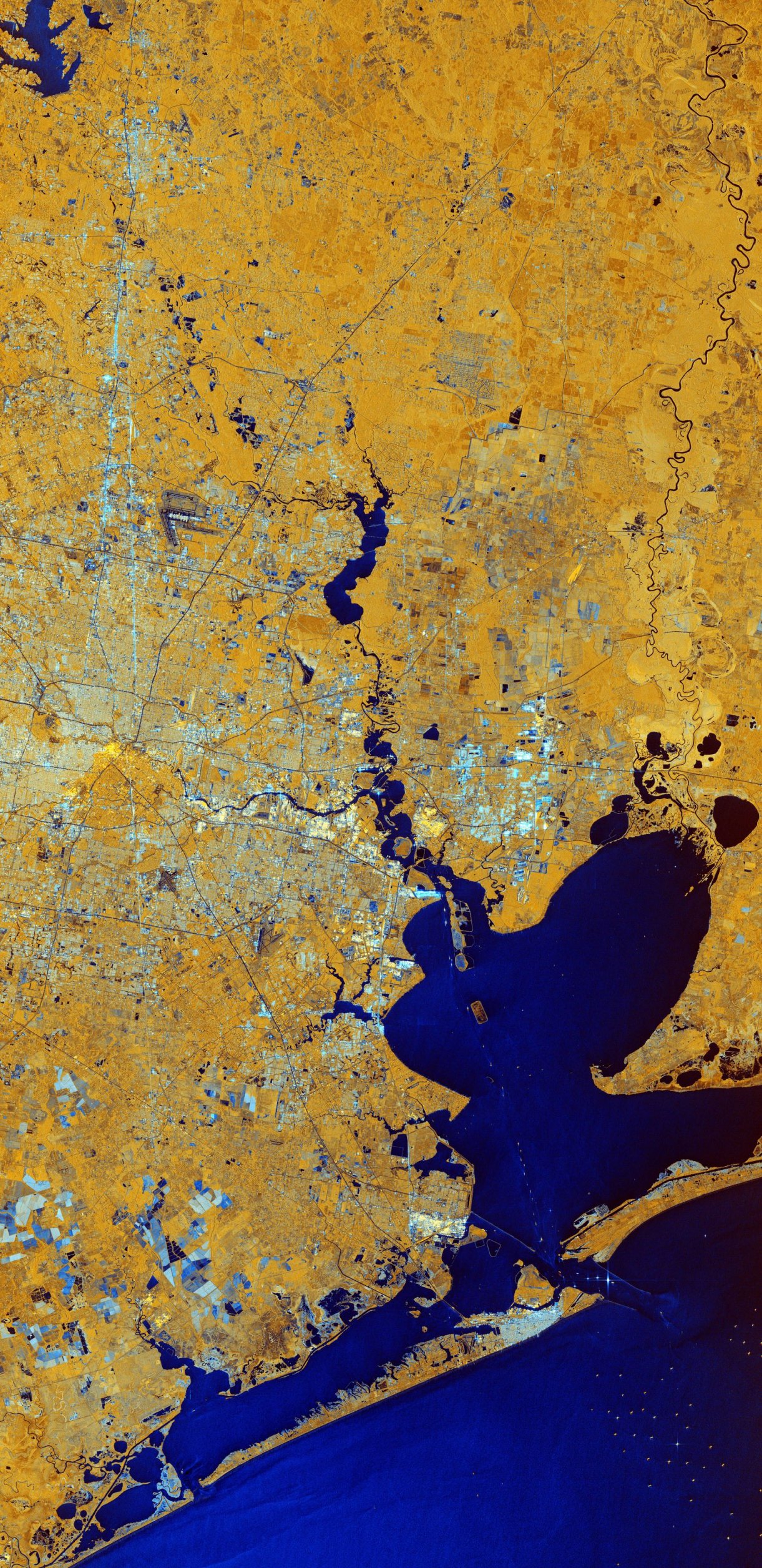Houston (Texas, USA) è mostrata in questa immagine catturata dalla missione Copernicus Sentinel-1.
I due satelliti gemelli Copernicus Sentinel-1 trasportano strumenti radar progettati per ottenere immagini della superficie della Terra. Le immagini acquisite tramite radar sono interpretate misurando l’intensità del segnale di ritorno diffuso verso il satellite, una quantità fisica che è in relazione con la rugosità del terreno.
I colori di questa acquisizione sono dovuti alla combinazione di due ‘polarizzazioni’ ottenute dal radar di Copernicus Sentinel-1, le quali che sono state poi trasformate in una singola immagine RGB. L’interpretazione della polarizzazione consente agli scienziati di analizzare la porzione superficie terrestre ripresa.
In questa immagine composita, ripresa il 21 giugno del 2019, è visibile la città di Houston, che appare con sfumature di bianco e grigio in contrasto con i toni gialli del territorio circostante e con le acque di colore blu scuro del Golfo del Messico.
Con una popolazione di oltre 2 milioni di individui e con un’area di copertura di oltre 1600 kmq Houston è la città più popolosa dello stato del Texas e la quarta città più grande degli USA.
Houston è divisa da una serie di aree paludose (‘bayous’). Si può osservare la Buffalo Bayou tagliare la città, prima di convergere nella Baia di Galveston visibile nella parte bassa dell’immagine. La Baia di Galveston è lunga approssimativamente 55 km e larga circa 30 km, dimensioni che la rendono il più grande estuario del Texas. La baia è poco profonda e presenta un livello medio dell’acqua di circa 2 m, che per la sua estensione risulta una profondità decisamente inusuale.
Il Porto di Houston, che si estende lungo il settore nord occidentale della baia, è uno dei più grandi porti al mondo e molte navi possono essere individuate come punti multicolore in basso a destra nell’immagine.
Houston ospita il Lyndon B.Johnson Space Center della NASA, che sorge ad ovest della Baia di Galveston. Il centro costituisce la principale struttura della NASA dedicata all’addestramento degli astronauti ed inoltre ha la funzione di centro di controllo operazioni per le missioni della Stazione Spaziale Internazionale. Durante i voli delle mission Apollo, Gemini e Space Shuttle veniva indicato come ‘ controllo missione’ o più semplicemente ‘Houston’.
Inoltre il centro collabora con altre istituzioni internazionali in una ampia varietà di programmi scientifici ed ingegneristici legati ai voli spaziali umani ed alla esplorazione planetaria.
Il Johnson Space Center è il luogo in cui molti astronauti dell’ESA vengono inviati per svolgere parte del loro addestramento e preparazione alle future missioni spaziali. Presso questo centro Luca Parmitano, che recentemente ha fatto il suo rientro sulla Terra, si è addestrato per la sua missione Beyond sulla Stazione Spaziale Internazionale.
Scarica immagine MediumRes (17,49 MB - .JPG)
Scarica immagine HighRes (379,88 MB - .TIF)
---
Houston, Texas
Houston, Texas, US, is featured in this image captured by the Copernicus Sentinel-1 mission.
The two identical Copernicus Sentinel-1 satellites carry radar instruments to image Earth’s surface. Images acquired with radar are interpreted by studying the intensity of the signal scattered back to the satellite – which is related to the roughness of the ground.
The colours of this week’s image come from the combination of two ‘polarisations’ from the Copernicus Sentinel-1 radar mission, which have been converted into a single RGB image. Interpreting polarisation can help scientists analyse Earth’s surface.
In this composite image, captured on 21 June 2019, the city of Houston appears in shades of white and grey which contrasts with the yellow tones of the surrounding land and the dark blue waters of the Gulf of Mexico.
With a population of over two million and covering an area of over 1600 sq km, Houston is the state’s most populous city and the fourth largest city in the US.
Houston is dissected by a series of bayous. Buffalo Bayou can be seen cutting through Houston, before joining Galveston Bay visible at the bottom of the image. Galveston Bay is around 55 km long and around 30 km wide, making it the largest estuary in Texas. The shallow bay has an average depth of around 2 m, which is unusually shallow for its size.
The Port of Houston, which spreads across the northwest section of the bay, is one of the world’s largest ports, and many ships can be seen as multi coloured dots in the bottom-right of the image.
Houston is home to the NASA Lyndon B. Johnson Space Center, which lies west of Galveston Bay. The centre acts as NASA’s lead centre for astronaut training as well as the International Space Station mission operations. It was identified as mission control or simply ‘Houston’ during the Apollo, Gemini and Space Shuttle flights.
The centre also collaborates with other international facilities in a variety of scientific and engineering programmes related to human space flight and planetary exploration.
The Johnson Space Center is where many ESA astronauts are sent as part of their training and preparation for future space missions. This is where Luca Parmitano, who recently returned to Earth, trained for his Beyond mission to the International Space Station.
(Fonte: ESA - Image of the week: "Houston, Texas". Traduzione: Gianluca Pititto)
Copia qui lo "short link" a questo articolo
www.geoforall.it/{sh404sef_shurl}




